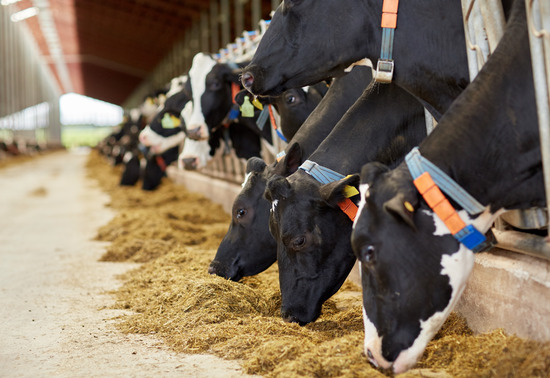
By Iory Hughes, livestock projects assistant at Innovation for Agriculture
Methane is a potent greenhouse gas that has 27.2 times (GWP100) the global warming potential of carbon dioxide (CO2). Cattle are responsible for producing 40% of global methane emissions. As a result, the livestock sector is under pressure to reduce enteric methane emissions from ruminants for the UK to reach net zero emissions by 2050.
Genetic variation in methane emissions
Methane emissions from cattle are primarily influenced by the feed they consume but researchers have also found notable differences in methane emissions from cows based on their genetic makeup. These lower methane producing genetic traits have been proven to be heritable meaning if lower methane emitting cows are selected for breeding, the lower methane emitting phenotype/trait can be passed to their offspring with an estimated 1% reduction in emissions per generation. If cattle are continuously selected based on lower methane production the emissions from the herd will continue to reduce over time.
The benefit of reducing methane emissions genomically is that the change is permanent, and emissions will be reduced whatever feed the cow is fed. This is in contrast to using some feed additives that, although they could reduce emissions to a greater extent in the short term, can only be fed as part of a TMR when cows are housed.
Improvement from selective breeding
To select from lower methane emitting cattle firstly methane emissions must be measured. The gold standard of measuring methane emissions is placing the animal in a respiration chamber where the composition of air inflow and outflow is measured to ascertain the volume of methane given off.
Commercially however this method is not viable. If genetic selection for lower methane producing cows was to become common practical on farm methods are required.
- Portable Gas Analysers/Sniffer devices placed near the cow’s nostrils or mouth detect methane as the cow exhales.
- Lazer Methane Detectors are aimed at the cows’ mouth and nose to measure methane.
- GreenFeed System is an automated feeder that entices cows with feed while measuring methane in their breath.
- Modelling and Estimation Techniques use data on feed intake, digestion, and cow activity to estimate emissions. Less accurate but cost effective.
Cool Cows project
The Cool Cows project at the SRUC is developing elite highly methane efficient animals. The aim is to understand the physiological differences in lower methane producing cattle. The project shows that by selecting for lower reducing methane in cows over generations emissions can be reduced. Hilda, the calf produced from mating the lowest methane producing Sire and Dam, was conceived using IVF meaning a sire from the United States could be used to maximise the lowest methane producing genetics available. More low methane cows have been born since Hilda and breeding from these heifers will enable the low methane producing trait to be bred into the herd.
Complexities of identifying lower methane producing genotypes
The most efficient method of selecting for lower methane emissions would be testing for a genotype. An article in the Journal of Biotechnology by Destaw Worku outlined the challenges faced when identifying genes responsible for methane emissions. The first challenge, as with most traits, is that methane emissions are controlled by many genes spread across the animals DNA with no single candidate gene solely responsible. This makes identifying whether an animal is likely to produce less methane difficult. The spots on the DNA where methane emissions are controlled are called QTLs (quantitative trait loci) and some QTLs responsible for lower methane emissions have been identified. Due to the difficulties in regularly measuring methane emissions however, very few methane related QTLs have been discovered. More research is needed to find all the important genes and DNA changes involved in methane production but new tools like GWAS (Genome-Wide Association Studies) and TWAS (Transcription-Wide Association Studies) will accelerate identifying these genes.
Should we select animals based on methane emissions?
The main driver of lowering CO2eq produced per litre of milk, the key measurement used for presenting the emissions from a dairy herd, is to improve the productivity, health and fertility of the dairy cow. This includes increasing the yield, number of lactations and the feed conversion of cows while minimising the age at first calving and continuing to have a good fertility rate throughout the cow’s lifespan.
These properties are already selectively bred for. The selection intensity of improving these genetic traits would be reduced if producing a lower methane producing cow was the priority. Semex won an innovation accolade at the Agromek agricultural fair in Denmark recently however for introducing their new breeding value for methane efficiency. Their aim is to reduces methane emissions by 20-30% without compromising milk yield, animal health or longevity. Integrating the methane efficiency index into existing indexes without compromising other traits will be key to lowering CO2eq per litre of milk but as O. Gonzalez-Recio et al., (2020) warned in the Journal of Dairy science, there is still a possibility a focus on reducing methane emissions could lead to a deceleration in genetic gain of other production traits.
Are lower methane producing cows the future?
Lower methane producing cows have the potential to significantly reduce emissions. Identifying genes responsible for the trait to enable selection in a commercial setting will be a key step to decreasing methane emissions. The challenge will be introducing the genetic trait while continuing to improve other key genetic traits required for herds to minimise emissions.




